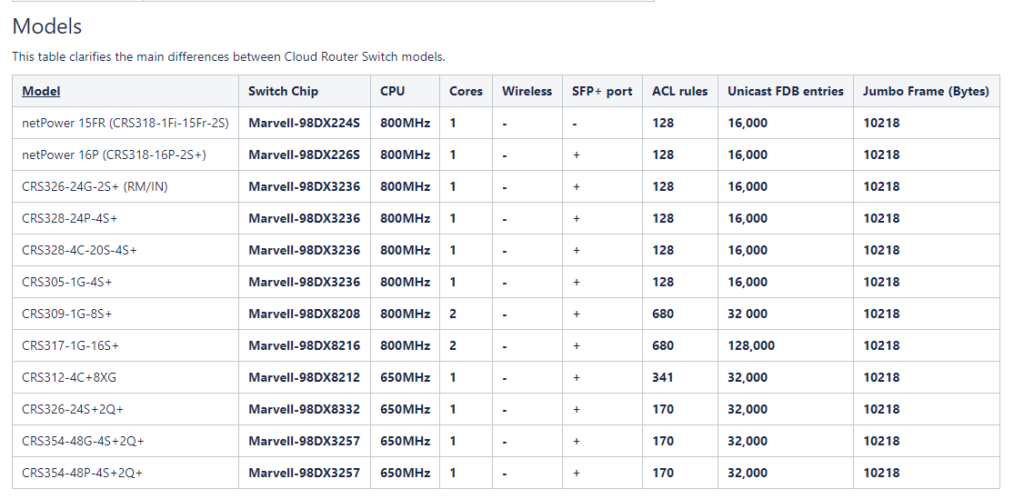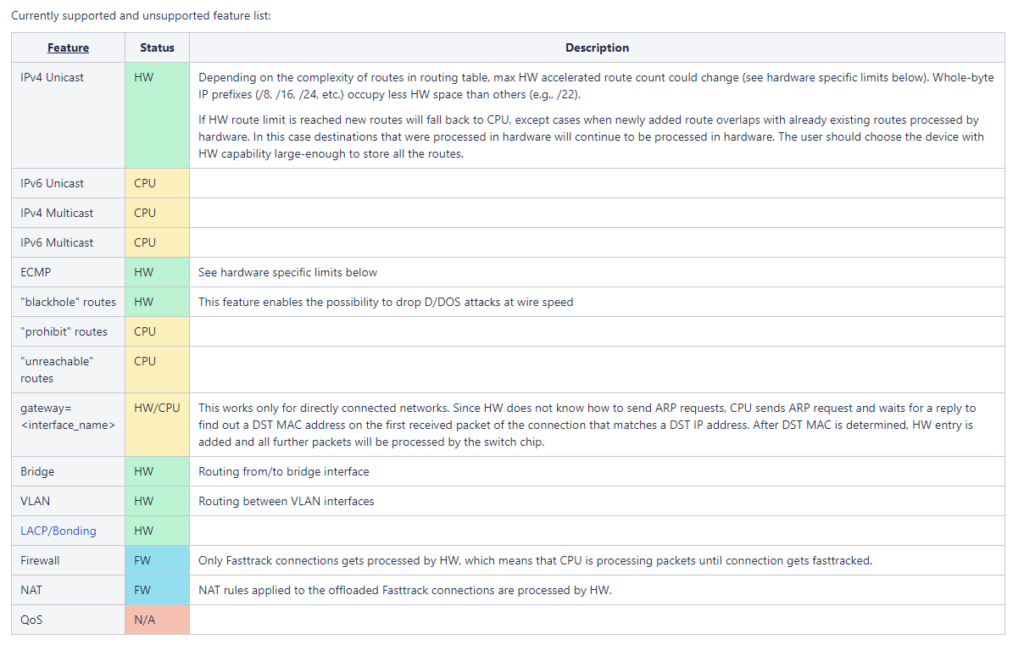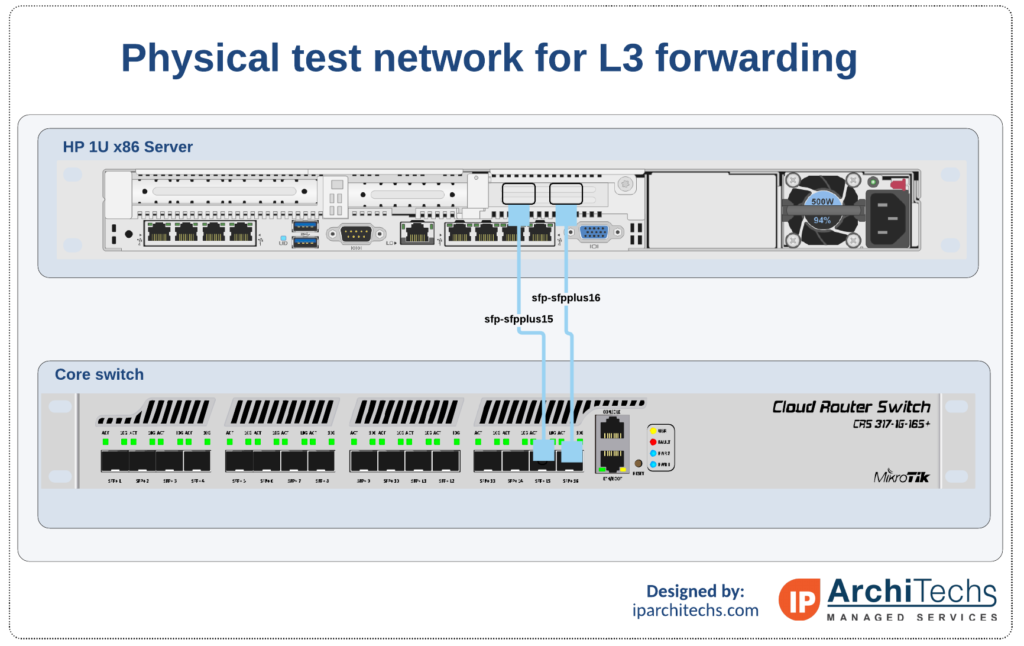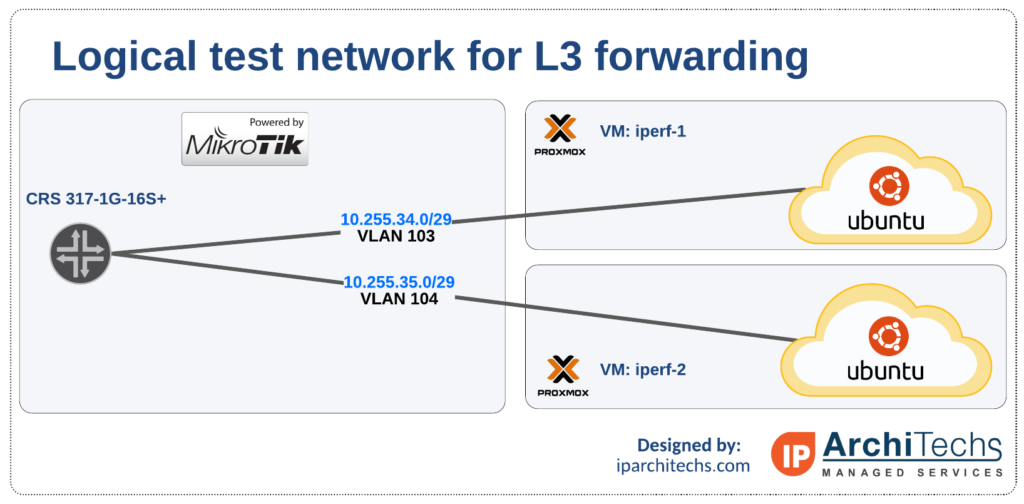
When MikroTik announced the CRS3xx series switches a few years ago, one of the most exciting aspects of that news release was the prospect of L3 forwarding in hardware on very inexpensive devices.
A quick review of the Marvell Prestera ASIC family showed a number of advanced routing, switching, MPLS and VxLAN capabilites.
Fast forward to 2020, where MikroTik has started to enable some of those features in RouterOS v7 beta.
Now we can finally take some of the CRS3xx switches and test their capabilities with L3 forwarding performance in hardware
CRS 3xx series capabilities overview
Before getting into the testing, it’s probably helpful to review some of the basic specs and capabilities of the CRS3xx switch line.
Here is a chart from MikroTik that outlines ACL rule count, Unicast FDB entries and MTU size.
CRS 3xx model comparison

MIkroTik has been working on the development of the features listed below to offload into hardware.
For the tests in this article, we’ll be using IPv4 Unicast and Inter-VLAN routing.
Supported feature list

Currently, the following switches are supported.
For the testing in this article, we are using the CRS317-1G-16S+
Switches supported by 7.1beta2

Performance testing – overview
The physical setup for testing is fairly straightforward.
- HP DL380 gen7 with ProxMox PVE 6.2-4
- 2 x 10G Multimode OM4 fiber jumpers
- 4 x 10G Multimode SFPs
- CRS 317-1G-16S+ running RouterOS 7.1beta2

The logical setup is also very straightforward
- ProxMox/KVM hypervisor using PVE 6.2-4
- Two RFC1918 subnets and VLANs to test intervlan routing performance
- Two Ubuntu 20.04 LTS VMs
- iperf3 on both Ubuntu VMs

MikroTik Configuration
/interface bridge add mtu=9216 name=bridge1 vlan-filtering=yes add name=lo0 /interface ethernet set [ find default-name=sfp-sfpplus15 ] comment="Proxmox - ens2f0" l2mtu=10218 mtu=9216 set [ find default-name=sfp-sfpplus16 ] comment="Proxmox - ens2f1" l2mtu=10218 mtu=9216 /interface vlan add interface=bridge1 mtu=9216 name=vlan103 vlan-id=103 add interface=bridge1 mtu=9216 name=vlan104 vlan-id=104 /interface ethernet switch set 0 l3hw=yes /ip pool add name=dhcp_pool0 ranges=10.255.34.11-10.255.34.254 add name=dhcp_pool1 ranges=10.255.35.2-10.255.35.254 /ip dhcp-server add address-pool=dhcp_pool0 disabled=no interface=vlan103 name=dhcp1 add address-pool=dhcp_pool1 disabled=no interface=vlan104 name=dhcp2 /ip vrf add list=all name=main /interface bridge port add bridge=bridge1 interface=sfp-sfpplus15 pvid=103 add bridge=bridge1 interface=sfp-sfpplus16 pvid=104 /interface bridge vlan add bridge=bridge1 tagged=bridge1 untagged=sfp-sfpplus15 vlan-ids=103 add bridge=bridge1 tagged=bridge1 untagged=sfp-sfpplus16 vlan-ids=104 /ip address add address=10.255.34.1/24 interface=vlan103 network=10.255.34.0 add address=10.255.35.1/24 interface=vlan104 network=10.255.35.0 /ip dhcp-server network add address=10.255.34.0/24 dns-server=9.9.9.9 gateway=10.255.34.1 add address=10.255.35.0/24 dns-server=9.9.9.9 gateway=10.255.35.1
Test #1 – iperf3 testing at 96 byte MTU
CPU – 0% to 3%
CRS 317 – interface sfp-sfpplus15

iperf3 results

Test #2 – iperf3 testing at 512 byte MTU
CPU – 0% to 3%
CRS 317 – interface sfp-sfpplus15

iperf3 results

Test #3 – iperf3 testing at 1500 byte MTU
CPU – 0% to 3%
CRS 317 – interface sfp-sfpplus15

iperf3 results

Conclusions
The initial results are very promising. Getting close to 10G sustained L3 throughput using an ASIC on a device that lists for $399 USD is unheard of.
The most noteworthy items for improvement are the number of TCP retransmits in the iperf testing and the speed reduction as the MTU is reduced.
Normally, most ASIC based platforms will push 96 bytes through as fast as 1500 bytes. The retransmits suggest that more work is needed in the way RouterOS interfaces with the switching buffers for L3 HW offload
This is also on a beta version of RouterOS that will still go through many revisions before going into prod so I would expect to see the performance to improve as the code matures.
All things considered though, things are looking great to take the CRS3xx series and be able to deploy them as a true L3 switch in prod sometime in 2021.
Hey! Thanks for posting this, this is really helpful.
I tried using your exact config on a CRS317 with 7.1beta3 and for some strange reason Level 3 hw offloading does not seem to be working. Inter-vlan routing goes through the CPU no matter what I try.
Do you know if there’s something that I might need to do outside of the config?
I installed routerOS + firmware and started from a clean reset.
Another thing I noticed is there is no option for l3hw=fw as it says there should be in the docs. Maybe support was removed in beta3?
L3 offload is broken in 7.1beta3; Beta 4 has been released, fixing this and offering a more versatile implementation of L3 offload which now allows enabling the feature per-port.
Tried it on a CRS305 with 7.1b6. Got a little over 200Mb/s. Yep, bits. Here is the /export
/interface bridge
add mtu=9216 name=bridge1 vlan-filtering=yes
add name=lo0
/interface ethernet
set [ find default-name=sfp-sfpplus3 ] comment=”Proxmox – ens2f0″ l2mtu=10218 \
mtu=9216
set [ find default-name=sfp-sfpplus4 ] comment=”Proxmox – ens2f1″ l2mtu=10218 \
mtu=9216
/interface vlan
add interface=bridge1 mtu=9216 name=vlan103 vlan-id=103
add interface=bridge1 mtu=9216 name=vlan104 vlan-id=104
/interface ethernet switch
set 0 l3-hw-offloading=yes
/interface wireless security-profiles
set [ find default=yes ] supplicant-identity=MikroTik
/ip pool
add name=dhcp_pool0 ranges=10.255.34.11-10.255.34.254
add name=dhcp_pool1 ranges=10.255.35.2-10.255.35.254
/ip dhcp-server
add address-pool=dhcp_pool0 disabled=no interface=vlan103 name=dhcp1
add address-pool=dhcp_pool1 disabled=no interface=vlan104 name=dhcp2
/interface bridge port
add bridge=bridge1 interface=sfp-sfpplus3 pvid=103
add bridge=bridge1 interface=sfp-sfpplus4 pvid=104
/interface bridge vlan
add bridge=bridge1 tagged=bridge1 untagged=sfp-sfpplus3 vlan-ids=103
add bridge=bridge1 tagged=bridge1 untagged=sfp-sfpplus4 vlan-ids=104
/ip address
add address=10.255.34.1/24 interface=vlan103 network=10.255.34.0
add address=10.255.35.1/24 interface=vlan104 network=10.255.35.0
/ip dhcp-server network
add address=10.255.34.0/24 dns-server=9.9.9.9 gateway=10.255.34.1
add address=10.255.35.0/24 dns-server=9.9.9.9 gateway=10.255.35.1
/system routerboard settings
set boot-os=router-os
Any ideas very welcome. We would love to use the CRS series, but lack of wire speed an issue.
Thanks
MikroTik just enabled L3 forwarding for all 3xx series switches (vs. just a few) with the latest release so it’s possible there may be some bugs. Your config looks correct. If it’s not working, I would post in the v7 beta forum at forum.mikrotik.com
Thank you. Will try testing on crs309 and crs317.
Kevin,
Took your advice and posted on MT forum. Apparently L3 forwarding doesn’t support large MTU’s yet, although it appeared to work for you. Perhaps they changed the coed when they expanded it to all CRS.
Like your work btw:)
Gotcha, that makes sense. There are definitely a lot of things changing weekly in ROSv7 so this isn’t surprising. The routing filters are being re-written because they were too complex.
Thanks for the feedback on my posts – always great to hear that people find it useful 🙂
Now that ROS is at 7.6 stable, have you re-run any of this testing? I was thinking of hooking up one of our 317 to our “pain box” (Cisco TRex) and seeing what it can do. It looks like unicast IPv6 is fully supported for HW offload now.